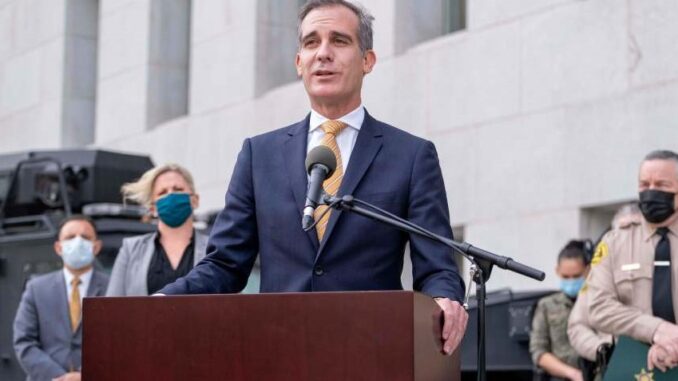
Energy News Beat Publishers Note: This is sad for the lower income and disproportionate impacted communities. They always pay the price, and our elected officials need to take care of them, rather than tax them past poverty.
The dictionary definition of an emergency is “a serious, unexpected, and often dangerous situation requiring immediate action.”
There’s a new fashion in emergencies, however. They’re longer this season. Some of them are so long that they have to measured in geologic time, more like an eon or an epoch than an emergency.
That seems to be the case in Los Angeles, where Mayor Eric Garcetti has just announced a new Climate Emergency Mobilization Office. He said it will be a “source of solutions for this generational challenge.”
This is part of fulfilling Garcetti’s commitment to a Los Angeles Green New Deal. The city is trying to get to 100 percent renewable energy by 2045. This effort has included the expensive conversion of a Utah power plant from coal to natural gas and eventually to hydrogen, which is technically possible but has never been done at this scale. No one knows if it will work or how much it will cost.
The city has also decided to phase out gas-powered generating plants that rely on ocean water for cooling. LADWP has not yet provided a detailed explanation of the power supply sources that will replace the decommissioned plants in the next decade, so we don’t know what that will cost, either.
But never mind the cost, because the city of Los Angeles sets the electricity and water rates that the LADWP charges captive customers, and the latest rate ordinance, approved in 2016, lifted the caps on adjustment factors and made other changes to ensure that all costs could be seamlessly passed through to customers.
This made the bond rating agencies on Wall Street very happy. No matter how much money LADWP borrows to cover the cost of decommissioning proven, inexpensive technology and replacing it with unproven, high-cost technology, the customers of the city-owned utility have no choice except to pay the bills.
Earlier this month Fitch Ratings praised the credit-worthiness of LADWP’s power system revenue bonds, noting the utility’s “very strong ability to raise revenue” and “very strong rate flexibility.”
Wait until you hear how this works. Because of economic and weather factors, revenue from LADWP’s retail electric sales declined approximately 4 percent in fiscal year 2020 from the previous year. And 2019 sales declined 2.2 percent from 2018. But LADWP has a “revenue decoupling feature in its electric rates,” Fitch exulted. When sales decline, the rates are raised the following year to make up the losses.
So if the population declines, businesses leave the city and electricity sales fall, rates go up. It’s like an air conditioned death spiral.
So we should be very concerned about the use of the term “climate emergency” and the consequent conversion to possibly unreliable green energy sources that cost much more than the dependable sources we’re so piously giving up.
This is a state policy as well as a city policy, and it’s about to go national. This is the Green New Deal ideology, the belief that the use of so-called fossil fuels must be halted, money no object. Where is the concern from government officials for the millions of people who are unable to pay rising utility bills and for the businesses and jobs that are leaving the state in part because of the high cost of energy?
That’s not on the priority list. The Climate Emergency Mobilization Office has been tasked with taking input on “environmental justice” and “civic engagement,” but not energy poverty.
LADWP’s last five-year rate package raised rates, both through the base-rate increases and the rate-adjustment factors, between 3.6 percent and 5.2 percent annually for different types of retail energy users. The new multi-year rate package was scheduled to be proposed this month, but Fitch Ratings reports this “has been delayed in consideration of the broad economic pressures in the service area.” Watch for it.
LADWP recently gave public presentations on its LA100 plan, a study of how the city is going to get to 100 percent renewable energy by 2045 or even earlier. Researchers have not yet finished the study.
A representative of one advisory group working on the plan said LADWP’s “investment in clean energy” must benefit minorities and low-income renters.
Before we go further down the path toward these “investments,” we should look up the dictionary definition of “benefit.”



